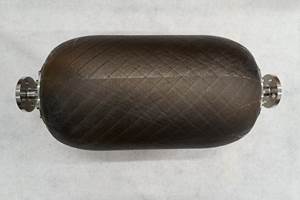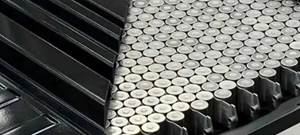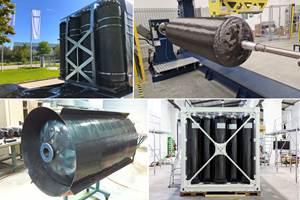AMRC develops 3D woven composite components for fusion nuclear reactor
The University of Sheffield AMRC is developing a ceramic composite breeder blanket capable of withstanding the extreme temperatures in a nuclear reactor.

Source | AMRC
The University of Sheffield Advanced Manufacturing Research Centre (AMRC; Catcliffe, U.K.), in collaboration with the United Kingdom Atomic Energy Authority (UKAEA; Abingdon, U.K.), is developing a 3D woven composite breeder blanket component capable of withstanding extreme temperatures inside a fusion nuclear reactor, as part of an effort to accelerate delivery of limitless zero-carbon fusion energy.
The work was commissioned by the Joining and Advanced Manufacturing (JAM) program, which forms one of three Fusion Technology Facilities at UKAEA. The AMRC, part of the High Value Manufacturing (HVM) Catapult, worked with Dr. Lyndsey Mooring, technical lead for non-metallics at UKAEA, to explore how composite materials could produce components that are stiffer, lighter and easier to manufacture than those currently in use, but which retain the necessary capabilities.
The UKAEA is involved in developing a next-generation magnetic confinement reactor — called a tokamak — at its site in Culham, Oxfordshire, U.K. Research is focused on preparing for an international tokamak experiment at the International Thermonuclear Experimental Reactor (ITER) in Saint-Paul-lès-Durance in southern France, and for the subsequent machine intended to demonstrate the generation of power from fusion.
In September 2019, the UKAEA announced that it would be building a new £22 million fusion energy research facility at the Advanced Manufacturing Park in Rotherham, U.K., that includes a test facility that reproduces the thermohydraulic and electromagnetic conditions in a fusion reactor. The center will work with industrial partners to commercialize nuclear fusion as a major source of low-carbon electricity.
Fusion occurs when two types of hydrogen atoms, tritium and deuterium, collide at enormously high speeds to create helium and release a high-energy neutron. Once released, the neutron interacts with a much cooler breeder blanket to absorb the energy. The breeder blanket must capture the energy of the neutrons to generate power, but also prevent the neutrons escaping and ‘breed’ more tritium through reactions with lithium contained in the blanket. Each blanket module typically measures about 1 by 1.5 meters and currently weighs up to 4.6 metric tonnes.
Up until now, breeder blanket designs have been made of steel, but the AMRC’s research involves developing a design that uses silicon carbide composite materials formed into a 3D woven structure with additively manufactured components.
“At the moment, the designs being tested in ITER use steel for the breeder blankets structure, which have a network of double walled tubes of 8-millimeter internal diameter and 1.25-millimeter wall thickness to collect the heat. Each one is welded into place and every connection has to be inspected. That is what we were asked to replace,” says Steffan Lea, research fellow at the AMRC Composite Centre. “Currently, their steel modules are limited to approximately 500˚C, so UKAEA asked us if there was anything we could do to get it up to 600˚C. We set out to see what materials we could use, that would enable higher temperature operation.”
For the proposed composite breeder blankets, the cooling tubes would be integrated into the material, and 3D-printed parts used to define features such as connectors and manifolds.
“We wanted to maximize the available surface area for heat transfer while being as lightweight as possible, but ensure it occupied a similar volume to the existing breeder blanket designs,” says Joe Palmer, senior project manager at the AMRC’s Design and Prototyping Group. “To achieve a lightweight, temperature-resistant structure, a silicon carbide composite material was chosen for the breeder blanket, with the internal flow channels being created by forming the composite around a disposable core.”
After a computer-aided design (CAD) model was produced, Chris McHugh, dry fiber development manager at the AMRC Composite Centre, created a weave design for the composite. “The design I created had multiple weave zones and had multiple layer weaves. The structure needed holes robust enough to include tubes and needed to maintain the preform shape without distortion. What we were able to produce on the loom was a 3D woven structure with pockets for the 3D-printed tubes which could be formed into a ridged component,” McHugh says.
The next step, according to Dr. Elizabeth Surrey, head of technology at the UKAEA, is to continue silicon carbide composite development and build a demonstrator that can be tested inside a reactor test facility in order to understand how it performs and reacts to the environment.
“If nuclear fusion is going to be realized, you need a simple design for breeder blankets that are manufacturable and easily replicated. That is what we have tried to create,” Surrey says.
Related Content
NCC reaches milestone in composite cryogenic hydrogen program
The National Composites Centre is testing composite cryogenic storage tank demonstrators with increasing complexity, to support U.K. transition to the hydrogen economy.
Read MoreComposites end markets: Batteries and fuel cells (2024)
As the number of battery and fuel cell electric vehicles (EVs) grows, so do the opportunities for composites in battery enclosures and components for fuel cells.
Read MoreHexagon Purus opens new U.S. facility to manufacture composite hydrogen tanks
CW attends the opening of Westminster, Maryland, site and shares the company’s history, vision and leading role in H2 storage systems.
Read MoreComposites end markets: Pressure vessels (2024)
The market for pressure vessels used to store zero-emission fuels is rapidly growing, with ongoing developments and commercialization of Type 3, 4 and 5 tanks.
Read MoreRead Next
All-recycled, needle-punched nonwoven CFRP slashes carbon footprint of Formula 2 seat
Dallara and Tenowo collaborate to produce a race-ready Formula 2 seat using recycled carbon fiber, reducing CO2 emissions by 97.5% compared to virgin materials.
Read MoreVIDEO: High-volume processing for fiberglass components
Cannon Ergos, a company specializing in high-ton presses and equipment for composites fabrication and plastics processing, displayed automotive and industrial components at CAMX 2024.
Read MoreDeveloping bonded composite repair for ships, offshore units
Bureau Veritas and industry partners issue guidelines and pave the way for certification via StrengthBond Offshore project.
Read More
.jpg;width=70;height=70;mode=crop)























